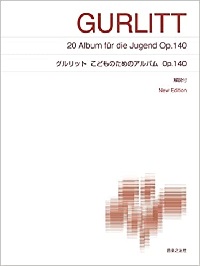Gurlitt, Cornelius : Der erste Vortrag Liedchen Op.210-2
Work Overview
Genre:pieces
Copyright:Public Domain
Commentary (1)
Author : Kumamoto, Ryohei
Last Updated: May 30, 2025
[Open]
Author : Kumamoto, Ryohei
The piece is in C major and is structured in ternary form.
Section A [a (measures 1-8) + a1 (measures 9-16)]
Section B [b (measures 17-20) + b1 (measures 21-28)]
At measure 28, a Da Capo al Fine instruction leads back to Section A. The piece then concludes at measure 16, confirming its ternary form.
The theme is predominantly diatonic; within its eight measures, non-harmonic tones appear only in measures 6-7 (specifically, E as an auxiliary tone in measure 6, and D as a passing tone in measure 7). As passing tones and auxiliary tones are non-harmonic tones adjacent to and leading towards harmonic tones, they function as transitional points. Therefore, such non-harmonic tones are not to be expressed individually but rather as a unified entity encompassed by harmonic tones. This characteristic allows melodies featuring non-harmonic tones like passing tones and auxiliary tones to possess a smooth melodic contour. In this work, compared to Section A, which contains fewer non-harmonic tones, Section B features the repetitive development of figures incorporating auxiliary tones. This suggests that Section B possesses a smoother character than Section A.
The left hand is entirely composed of harmonic tones, representing the harmonic function and sonority. In Section A, the tonic functions as a pedal point, and a dominant seventh chord on the tonic can be observed in measures 5-6 of the theme. Thus, harmonic variation is limited in Section A. Conversely, in Section B, measures 17-24 feature a two-measure sequence, allowing for a greater sense of harmonic progression.
Given these distinct characteristics between Sections A and B, the piece should not be regarded merely as a finger exercise; rather, these features should be leveraged in performance expression.
Arrangements & Related Works(1)
Sheet Music
Scores List (8)

(株)ヤマハミュージックメディア

(株)全音楽譜出版社

(株)全音楽譜出版社

(株)ヤマハミュージックエンタテインメントホールディングス

(株)全音楽譜出版社

(株)ヤマハミュージックエンタテインメントホールディングス

(株)ヤマハミュージックメディア


